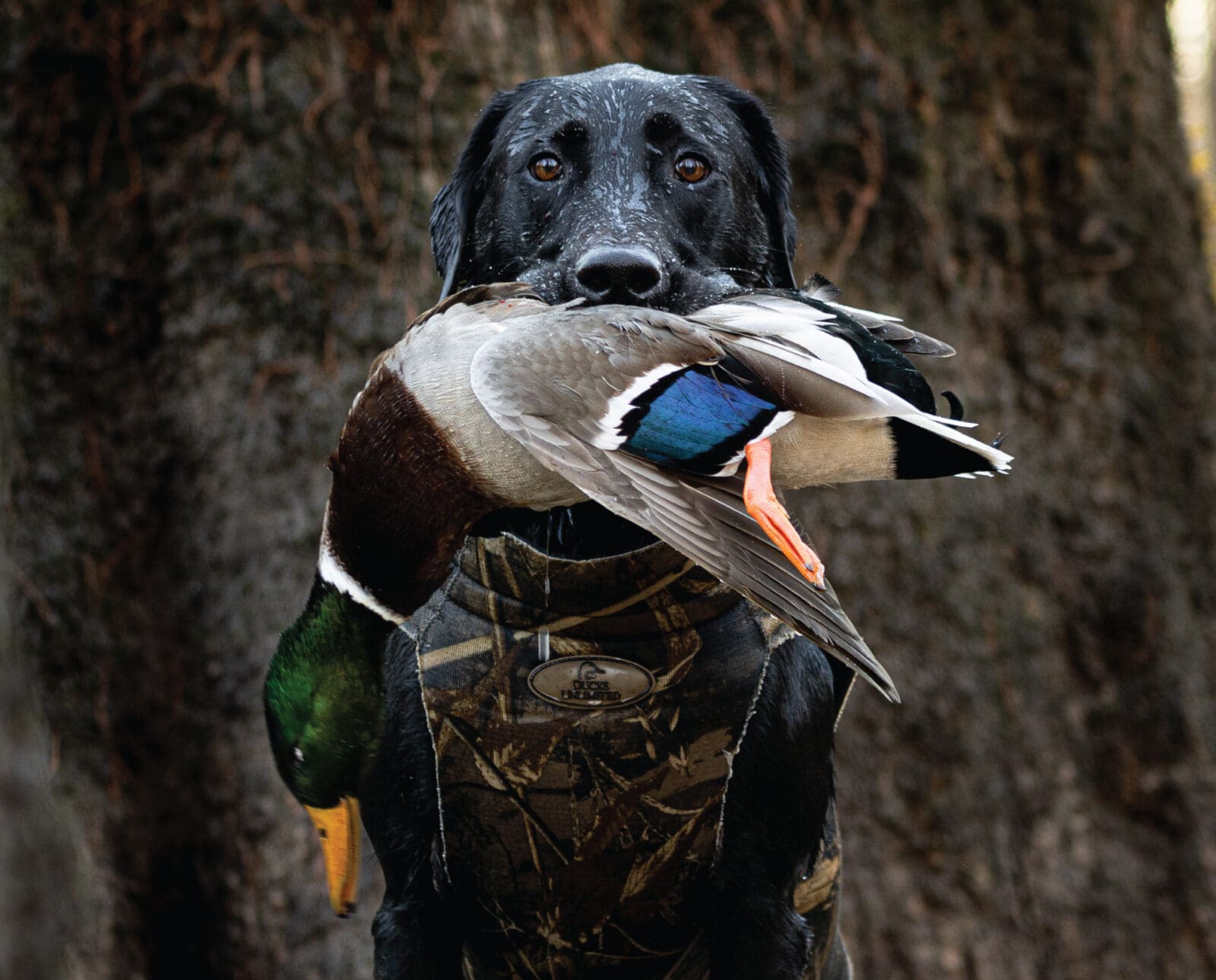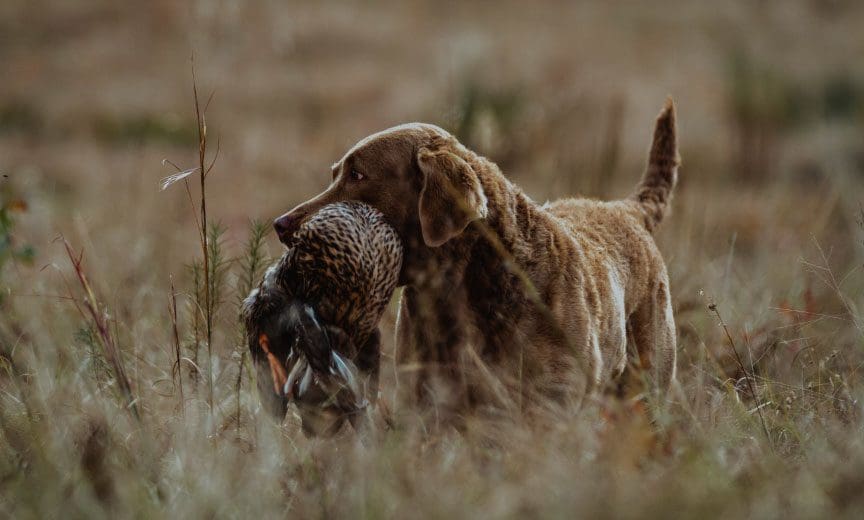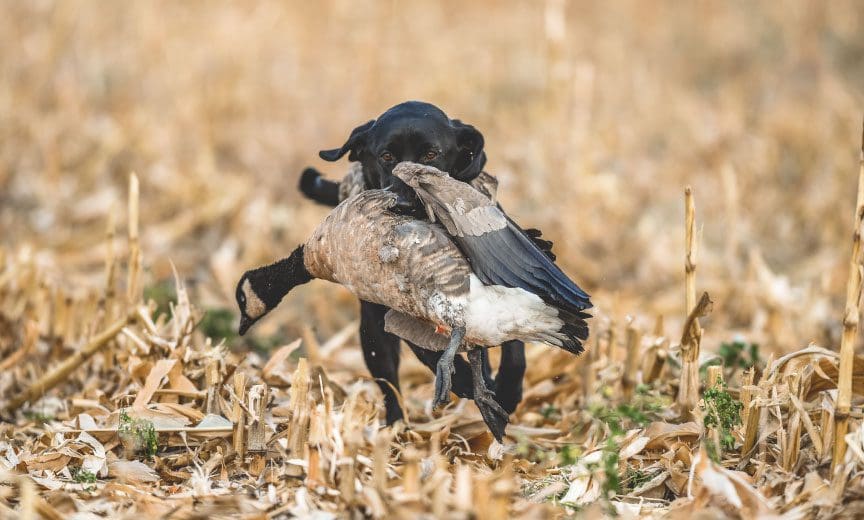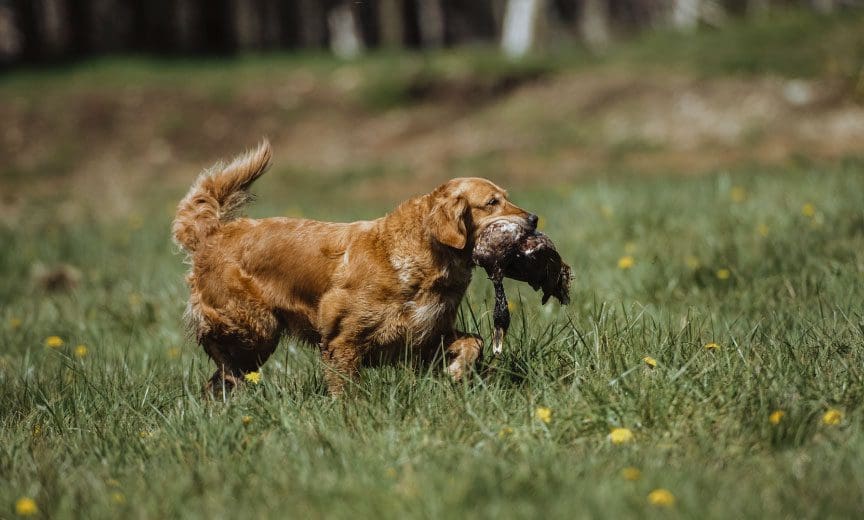Home » Hunting Dogs » Flagship Retrievers – A Legacy of Waterfowl Dogs
Flagship Retrievers – A Legacy of Waterfowl Dogs

Nancy Anisfield is an outdoor writer and hunting dog photographer,…
A History and Exploration into the World of Retrievers as Waterfowl Gun Dogs
Think big water retrievers and Labradors, Chesapeake Bays, and goldens are the first to come to mind – for good reason. They can handle just about any type of retrieving in any type of water in any type of weather. Several Ducks Unlimited sources confirm their popularity, ranking them the top three duck dog breeds. Bred for hunting (as opposed to the show ring), Labs, Chessies, and goldens are the flagship retrievers in the waterfowl world.
Hard core duck hunters’ love of these breeds could be attributed to a combination of three key characteristics. First is size. Considered medium to large, size gives these dogs a strength advantage when it comes to fighting currents or carrying heavy waterfowl. Second is a having a dense double coat that insulates the body and repels water. The third characteristic quite simply is smarts. This manifests itself in trainability, marking, and the ability to adapt to varied situations with a balance of independence and cooperation.
All three of these breeds were purposely developed to be rugged, reliable workers. The Lab breed originated with the St. John’s Water dog of Newfoundland (not Labrador) that hauled nets for fishermen and allegedly would dive under water to retrieve fish that slipped their hooks. Sheep protection policies and rabies quarantines led to the demise of the St. John’s dog, but several English nobles used a few St. John’s as the foundation for a breeding program that refined the Labrador as its own breed.
Chessies also came from St. John’s dogs, specifically two pups that were rescued from a sinking shipful of drunken sailors. They were bred to local dogs on the Maryland shore creating lines of strong retrievers suited to the demanding market gunning conditions of the Chesapeake Bay where they were often called on to make over 100 retrieves in a day.

For years, it was thought that the golden retriever descended from a troupe of Russian circus dogs. Records kept by Scottish businessman Dudley Marjoribanks, the first Baron of Tweedmouth, disproved that theory. Marjoribanks founded the breed starting with an unregistered yellow retriever and a Tweed water spaniel. The need for a tough retriever with strong water drive motivated him to develop a dog that could handle Scotland’s harsh climate and difficult marsh waterfowl hunting.
All of these retrievers should be able to carry a large goose with ease. Their well-muscled necks support waterfowl in choppy water while the more pronounced webbing between their toes gives them a strong paddle. Since these breeds were designed to work in frigid waters of the North Atlantic, having that water-repellent double coat is essential. Be it the Lab’s smooth coat, the Chessie’s oily and curly coat, or the golden’s long wavy coat, the dense underlayer provides protective warmth and repels water while the outer layer dries quickly. They all shed equally.
Ask an owner or breeder to describe these flagship waterfowl retrievers and inevitably intelligence will come up. Editor Emeritus of Retriever Journal and Pointing Dog Journal Steve Smith explains the importance of brainpower in a retriever. “A great dog learns quickly, which means getting a finished dog sooner than if you’re trying to train a hammerhead. A smart dog learns to compensate for his own shortcomings; he teaches himself, which defines experience. He’ll mark off the gun, watch carefully, and let the memory that comes with high intelligence help him out. The best dogs usually end up being the smartest ones.”
External appearances aside, with size, coat quality, and smarts being equal, what sets these breeds apart? Temperament and training approach would be the answer. The consensus is that goldens are the most calm, sociable, and obedient. Labs are considered to be the most flexible, even-tempered, and biddable. Chessies are known as thinkers, tremendously loyal, and stubborn.
The question often arises as to which Labs – American or British – make better waterfowl dogs. Tom Dokken, author of Retriever Training: The Complete Guide to Developing Your Hunting Dog, has trained and hunted over many of each. He writes, “Good field blood lines produce good upland dogs in both cases. Field bred British Labs can hold up in the pheasant fields as well as the American Labs. The American Labs’ drive gives them an advantage when it comes to late season, big-water waterfowl work, but the two types are not way apart on two sides of the fence when it comes to training or working.”

Chessie breeder Sharon Potter, owner of Red Branch Kennels, points out that some of the differences harkens back to how the dogs were developed. “While Labs have been bred for trainability – to follow directions from humans – Chesapeakes were developed to grow up to work and hunt pretty much straight out of the box, without much training at all. That speaks to a strength of instinct that is a lot closer to the wild than most other hunting breeds . . . It is that very strength of instinct that often gives them a reputation for being stubborn,” Sharon explains.

Goldens are willing trainees and eager to please. Those from strong field lines – show and companion-only lines should be avoided – take to water enthusiastically. As a breed they are softer and more sensitive than Labs or Chessies, less likely to shake off harsh corrections or inconsistencies in handling.
Most waterfowl hunters seeking a flagship retriever will gravitate towards one breed or another based on a gut level attraction which usually results in hunter and dog being well-suited to each other. With any of these breeds, however, it is safe to say that when the whistlers jack into decoys bobbing in two-foot chop on a sleety mid-December morning and the guns drop a pair out 50 yards, the duck will be brought to the boat.
Nancy Anisfield is an outdoor writer and hunting dog photographer, creative director for the Ugly Dog Hunting Company, member of the Pheasants Forever / Quail Forever Board of Directors, and co-owner of the Track2Wing Project which grants Action trackchairs to individuals with mobility challenges who want to train and hunt with bird dogs. She and her husband live in Hinesburg, Vermont, where their lives are governed by her two German shorthaired pointers and his two German wirehaired pointers.



